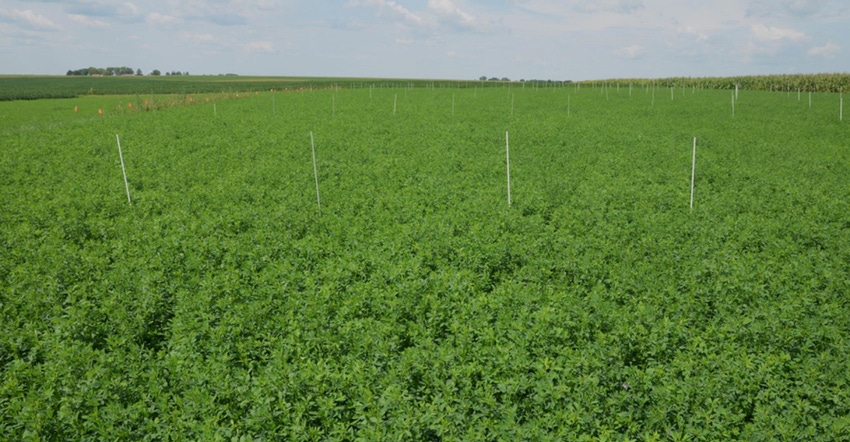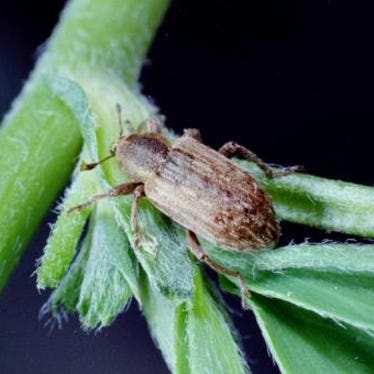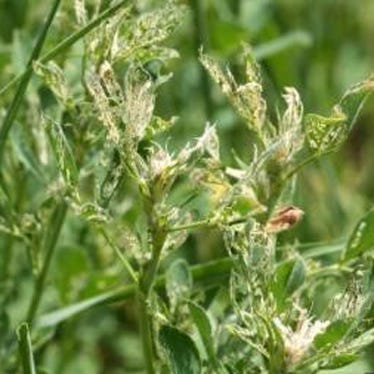May 7, 2018

It’s time to scout alfalfa fields for the presence of alfalfa weevil, which can be a major problem in some years. If you find this insect pest in your alfalfa field, check to see if it has reached the economic threshold level for treatment. If it has, then you probably need to apply an approved insecticide — depending on when you plan to make the first cutting for harvest.
“It’s been over a decade since we’ve seen a significant problem with this pest in northeast Iowa,” says Brian Lang, Iowa State University Extension field agronomist at Decorah. “But you never know when a larger population will appear.”
Watch degree day accumulation
That’s why Lang and other ISU Extension crop specialists track the growing degree days (base 48 degrees F) accumulation and provide a heads-up when it’s time to scout. Scouting begins at about 250 degree days after Jan. 1. A rough prediction based on the recent accumulation of GDDs in northeast Iowa is about 80 GDDs for the Highway 20 region to 50 GDDs for the Hwy. 18 region. A rough extrapolation based on this data puts 250 GDDs at about May 9 for the Hwy. 20 region and May 12 for the Hwy. 18 region.
You should scout an entire field for the presence of alfalfa weevil. “Greater risks would be on south-facing slopes and proximity to woodlands,” Lang says. “The quickest and easiest way to initially scout for alfalfa weevil is to use a sweep net just to survey a field. If there are some alfalfa weevils in the net, then refer to the scouting procedure and threshold information in the April 2018 article on the ISU Integrated Crop Management website.”
Adult alfalfa weevils become active and start laying eggs as soon as temperatures exceed 48 degrees F, says ISU Extension entomologist Erin Hodgson. Alfalfa weevil eggs develop based on temperature, or accumulating degree days, and hatching can start around 200 to 300 GDDs. In Iowa, you should start scouting alfalfa fields south of Interstate 80 at 200 GDDs and fields north of Interstate 80 at 250 GDDs. This year, based on accumulated temperatures since January, weevils began to become active in southern Iowa the last weekend in April.
Keep eye out
Alfalfa weevil is an important defoliating pest in alfalfa, says Hodgson, who provides the following information and management guidelines.

LARVAE: Alfalfa weevil larvae have a dark head and pale-green body with a white stripe down the back. Fully grown larvae are about 5/16 of an inch long.

Heavy infestations can reduce tonnage and forage quality. Adults feed on plants, but typically the larvae or worm stage of the alfalfa weevil causes most of the injury to plants. Female alfalfa weevils can lay from 800 to 4,000 eggs in a lifetime and insert from five to 20 at a time into alfalfa stems.
Newly hatched larvae can be found feeding on terminal leaves, leaving newly expanded leaves skeletonized. Maturing larvae move down the plant and begin feeding between leaf veins. Peak larval activity occurs around 575 GDDs. Often, you can find silken pupal cases attached to leaves in the lower canopy or in the leaf litter on the ground.

ADULTS: Alfalfa weevil adults have an elongated snout and elbowed antennae. Their wings and body are mottled or brown in color.

The time it takes for alfalfa weevil to reach the adult stage is dependent on temperature, but it can take about eight weeks. Adults eat along the leaf margin, leaving irregular notches. A heavily infested field will look frosted or silver.

WEEVIL DAMAGE: Heavily defoliated alfalfa fields appear frosted from a distance.

Scouting, management
After reaching benchmark degree days (200 in southern Iowa and 250 in northern Iowa), use a sweep net to sample for adults and larvae. South-facing slopes warm up faster and may be a place to start sampling. After larvae are first collected in sweep nets, collect six alfalfa stems from five locations throughout the field. Take each stem and vigorously shake into a bucket to dislodge larvae from the plant. Small larvae can be difficult to separate from the plant; therefore, careful plant inspection is also needed.
Average the number of larvae per 30 stems and average the plant height in the field to determine if the economic threshold is met; then use the table provided by Hodgson. Remember, cutting alfalfa is an effective management tool for alfalfa weevil larvae, and an insecticide application may be avoided if harvesting within a few days of reaching the economic threshold. View the table and information on how to interpret it.
Summing up: To make cost-effective treatment decisions for alfalfa weevil management, three things must be known:
1. What is the expected market value of the hay (dollar per ton)?
2. How much are the control costs (dollar per acre)?
3. How tall are the plants (inches)?
Source: Iowa State University
You May Also Like




